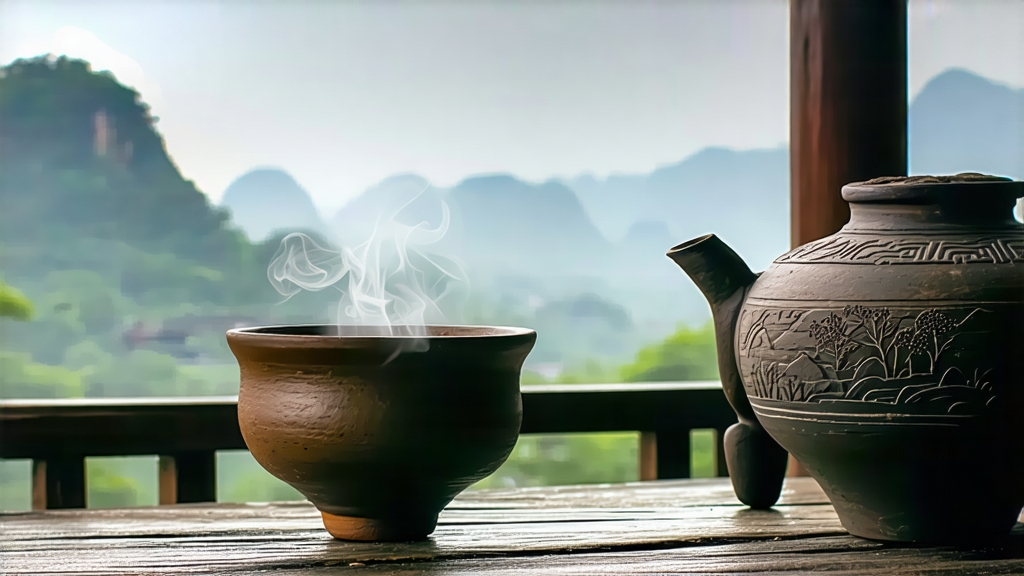
Tucked into the southern folds of China’s Guangxi Zhuang Autonomous Region, the small town of Liubao has given its name to one of the most intriguing members of the dark-tea family: Liu Bao. To most Western drinkers “dark tea” still evokes the malty familiarity of Yunnan’s ripe pu-erh, yet Liu Bao predates it by at least three centuries and carries a flavor profile that can astonish anyone who thinks they already know what “fermented” tea tastes like. From its role as the once-mandatory cargo of the ancient Tea-Horse Road’s southern spur to its modern revival among Chinese collectors, Liu Bao offers a liquid chronicle of humidity, patience, and microbial artistry.
Historical footprints
The earliest written record appears in the 36th year of the Jiajing Emperor (1557), when the Guangxi provincial gazetteer listed “Liubao” among tribute teas. Caravans leaving Wuzhou port carried compressed bamboo-wrapped baskets down the Xun River to Guangzhou, where foreign clippers waited. By the Qing dynasty the tea had become so indispensable to the Mongolian and Tibetan markets that imperial edicts fixed its price in silver taels. In 1886 a German missionary stationed in Hong Kong shipped 30 baskets to Hamburg, marking the first documented arrival of a Chinese dark tea in Europe—decades before pu-erh ever crossed a border. During the Pacific War the route was severed; Liu Bao faded into domestic obscurity until the 1950s when state-owned factories revived it to earn hard currency from Hong Kong and Macau tea houses. Today the original state-designated “Three Gold Coins” brand sells at auction for more than vintage pu-erh of equal age, and private artisans experiment with micro-lots that would have been unthinkable twenty years ago.
Micro-terroirs within one town
Liu Bao is not a single-garden tea; it is the collective output of a 480 km² micro-region where altitude ranges from 200 m along the river to 1,200 m on the limestone karsts. Gardens above 600 m yield slow-grown leaves rich in amino acids, giving a sweet, orchid-like aftertaste once the tea has aged. Lower plantations produce broader leaves with higher polyphenol oxidase activity—ideal for the wet-piling process that will generate the characteristic betel-nut aroma. The township officially recognizes six village clusters, each allowed to stamp its name on the basket: Tangping, Gonghe, Shanzui, Dali, Gaojian, and Wuxu. Connoisseurs speak of “Tangping elegance” versus “Gaojian muscularity” much as Burgundy lovers compare Volnay and Pommard.
Leaf standards and picking calendars
Only Camellia sinensis var. sinensis f. pubilimba, a local ecotype with fine white pubescence on the underside of leaves, is considered authentic. The first plucking window opens on Qingming day (early April) when the standard is one bud with three or four half-open leaves; this “first spring” material becomes the top grade destined for long aging. A second harvest occurs at Grain Rain (late April) and is used for quicker-consumption commercial lots. Summer leaves, thicker and more bitter, are reserved for mass-market brick production. Farmers avoid autumn plucking entirely; the dry air produces leaves that lack the enzymatic vigor needed for proper fermentation.
The craft of “wet-piling” Guangxi-style
Although the term “wo dui” (wet piling) is shared with ripe pu-erh, Liu Bao’s protocol differs in duration, temperature curve, and microbial consortia. Fresh leaves are kill-green at 280 °C for exactly 90 seconds to lock in a faint greenish core, then rolled for 40 minutes to rupture 65 % of cell walls. After sun-drying to 14 % moisture the maocha is moved into a humidified room kept at 28 °C and 85 % relative humidity. Workers build conical piles 1.2 m high on bamboo mats, spraying 8 % of the leaf weight in mountain spring water that has been inoculated with a mother culture drawn from a previous batch. Over the next 25 days the pile is turned seven times; thermocouples ensure the core never exceeds 55 °C, preventing the emergence of undesirable black spores. When the leaf surface turns walnut-brown and emits